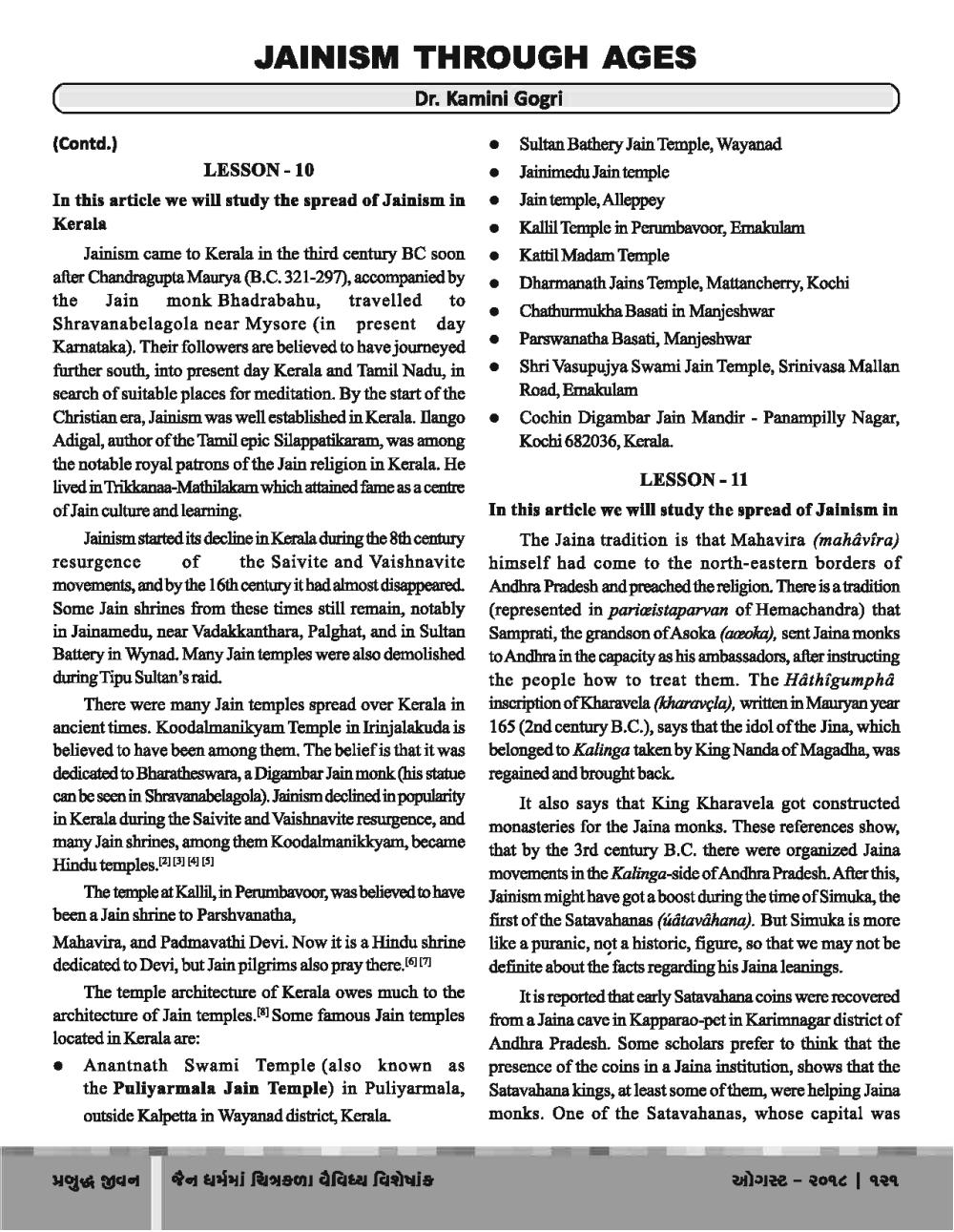________________
JAINISM THROUGH AGES
Dr. Kamini Gogri
•
. •
Sultan Bathery Jain Temple, Wayanad Jainimedu Jain temple Jain temple, Alleppey Kallil Temple in Perumbavoor, Emakulam Kattil Madam Temple Dharmanath Jains Temple, Mattancherry, Kochi Chathurmukha Basati in Manjeshwar Parswanatha Basati, Manjeshwar Shri Vasupujya Swami Jain Temple, Srinivasa Mallan Road, Emakulam Cochin Digambar Jain Mandir - Panampilly Nagar, Kochi 682036, Kerala.
(Contd.)
LESSON - 10 In this article we will study the spread of Jainism in Kerala
Jainism came to Kerala in the third century BC soon after Chandragupta Maurya (B.C.321-297), accompanied by the Jain monk Bhadrababu, travelled to Shravanabelagola near Mysore (in present day Karnataka). Their followers are believed to have journeyed further south, into present day Kerala and Tamil Nadu, in search of suitable places for meditation. By the start of the Christian era, Jainism was well established in Kerala. Ilango Adigal, author of the Tamil epic Silappatikaram, was among the notable royal patrons of the Jain religion in Kerala. He lived in Trikkanaa-Mathilakam which attained fame as a centre of Jain culture and learning.
Jainism started its decline in Kerala during the 8th century resurgence of the Saivite and Vaishnavite movements, and by the 16th century it had almost disappeared. Some Jain shrines from these times still remain, notably in Jainamedu, near Vadakkanthara, Palghat, and in Sultan Battery in Wynad. Many Jain temples were also demolished during Tipu Sultan's raid.
There were many Jain temples spread over Kerala in ancient times. Koodalmanikyam Temple in Irinjalakuda is believed to have been among them. The belief is that it was dedicated to Bharatheswara, a Digambar Jain monk (his statue can be seen in Shravanabelagola). Jainism declined in popularity in Kerala during the Saivite and Vaishnavite resurgence, and many Jain shrines, among them Koodalmanikkyam, became Hindu temples.[2][3] [4] [5]
The temple at Kallil, in Perumbavoor, was believed to have been a Jain shrine to Parshvanatha, Mahavira, and Padmavathi Devi. Now it is a Hindu shrine dedicated to Devi, but Jain pilgrims also pray there (17)
The temple architecture of Kerala owes much to the architecture of Jain temples. Some famous Jain temples located in Kerala are: • Anantnath Swami Temple (also known as
the Puliyarmala Jain Temple) in Puliyarmala, outside Kalpetta in Wayanad district, Kerala.
LESSON - 11 In this article we will study the spread of Jainism in
The Jaina tradition is that Mahavira (mahâvîra) himself had come to the north-eastern borders of Andhra Pradesh and preached the religion. There is a tradition (represented in pariæistaparvan of Hemachandra) that Samprati, the grandson of Asoka (amoka), sent Jaina monks to Andhra in the capacity as his ambassadors, after instructing the people how to treat them. The Hathigumphå inscription of Kharavela (kharavçla), written in Mauryan year 165 (2nd century B.C.), says that the idol of the Jina, which belonged to Kalinga taken by King Nanda of Magadha, was regained and brought back.
It also says that King Kharavela got constructed monasteries for the Jaina monks. These references show, that by the 3rd century B.C. there were organized Jaina movements in the Kalinga-side of Andhra Pradesh. After this, Jainism might have got a boost during the time of Simuka, the first of the Satavahanas (úåtaváhana). But Simuka is more like a puranic, not a historic, figure, so that we may not be definite about the facts regarding his Jaina leanings.
It is reported that early Satavahana coins were recovered from a Jaina cave in Kapparao-pet in Karimnagar district of Andhra Pradesh. Some scholars prefer to think that the presence of the coins in a Jaina institution, shows that the Satavahana kings, at least some of them, were helping Jaina monks. One of the Satavahanas, whose capital was
પ્રબુદ્ધ જીવન | જૈન ધર્મમાં ચિત્રકળા વૈવિધ્ય વિશેષાંક
ze - 2096 | 989




